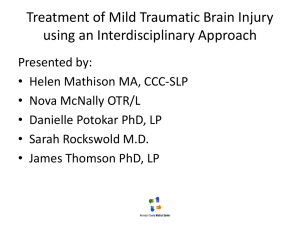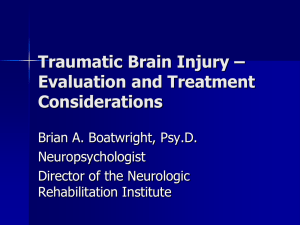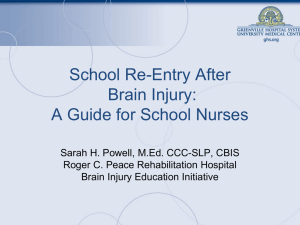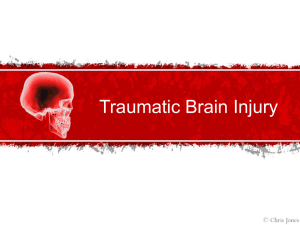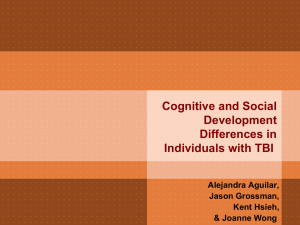Common data elements in radiologic imaging of traumatic brain injury.
advertisement
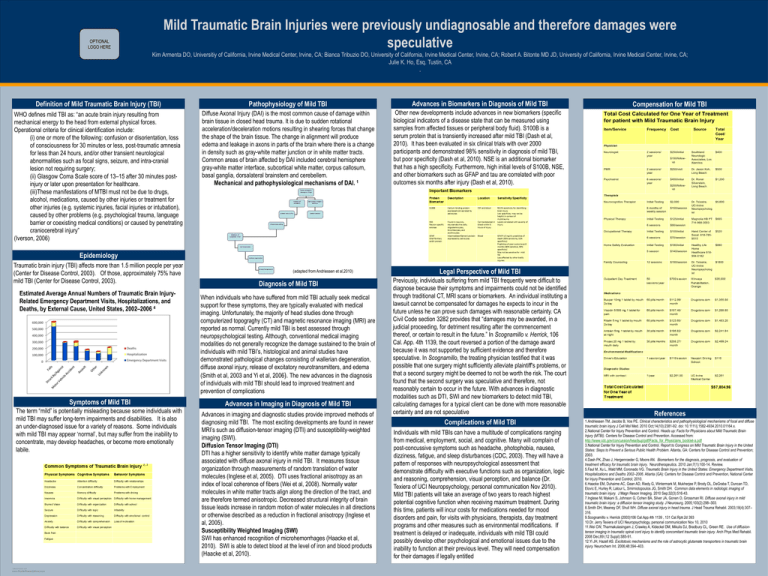
. Mild Traumatic Brain Injuries were previously undiagnosable and therefore damages were speculative OPTIONAL LOGO HERE Kim Armenta DO, Universitiy of California, Irvine Medical Center, Irvine, CA; Bianca Tribuzio DO, University of California, Irvine Medical Center, Irvine, CA; Robert A. Bitonte MD JD, University of California, Irvine Medical Center, Irvine, CA; Julie K. Ho, Esq. Tustin, CA . Definition of Mild Traumatic Brain Injury (TBI) Pathophysiology of Mild TBI Advances in Biomarkers in Diagnosis of Mild TBI WHO defines mild TBI as: “an acute brain injury resulting from mechanical energy to the head from external physical forces. Operational criteria for clinical identification include: (i) one or more of the following: confusion or disorientation, loss of consciousness for 30 minutes or less, post-traumatic amnesia for less than 24 hours, and/or other transient neurological abnormalities such as focal signs, seizure, and intra-cranial lesion not requiring surgery; (ii) Glasgow Coma Scale score of 13–15 after 30 minutes postinjury or later upon presentation for healthcare. (iii)These manifestations of MTBI must not be due to drugs, alcohol, medications, caused by other injuries or treatment for other injuries (e.g. systemic injuries, facial injuries or intubation), caused by other problems (e.g. psychological trauma, language barrier or coexisting medical conditions) or caused by penetrating craniocerebral injury” (Iverson, 2006) Diffuse Axonal Injury (DAI) is the most common cause of damage within brain tissue in closed head trauma. It is due to sudden rotational acceleration/deceleration motions resulting in shearing forces that change the shape of the brain tissue. The change in alignment will produce edema and leakage in axons in parts of the brain where there is a change in density such as gray-white matter junction or in white matter tracts. Common areas of brain affected by DAI included cerebral hemisphere gray-white matter interface, subcortical white matter, corpus callosum, basal ganglia, dorsalateral brainstem and cerebellem. Mechanical and pathophysiological mechanisms of DAI. 1 Other new developments include advances in new biomarkers (specific biological indicators of a disease state that can be measured using samples from affected tissues or peripheral body fluid). S100B is a serum protein that is transiently increased after mild TBI (Dash et al, 2010). It has been evaluated in six clinical trials with over 2000 participants and demonstrated 98% sensitivity in diagnosis of mild TBI, but poor specificity (Dash et al, 2010). NSE is an additional biomarker that has a high specificity. Furthermore, high initial levels of S100B, NSE, and other biomarkers such as GFAP and tau are correlated with poor outcomes six months after injury (Dash et al, 2010). Compensation for Mild TBI Epidemiology Traumatic brain injury (TBI) affects more than 1.5 million people per year (Center for Disease Control, 2003). Of those, approximately 75% have mild TBI (Center for Disease Control, 2003). Estimated Average Annual Numbers of Traumatic Brain InjuryRelated Emergency Department Visits, Hospitalizations, and Deaths, by External Cause, United States, 2002–2006 4 Symptoms of Mild TBI The term “mild” is potentially misleading because some individuals with mild TBI may suffer long-term impairments and disabilities. It is also an under-diagnosed issue for a variety of reasons. Some individuals with mild TBI may appear ‘normal’, but may suffer from the inability to concentrate, may develop headaches, or become more emotionally labile. TEMPLATE DESIGN © 2008 www.PosterPresentations.com (adapted from Andriessen et al,2010) Diagnosis of Mild TBI When individuals who have suffered from mild TBI actually seek medical support for these symptoms, they are typically evaluated with medical imaging. Unfortunately, the majority of head studies done through computerized topograghy (CT) and magnetic resonance imaging (MRI) are reported as normal. Currently mild TBI is best assessed through neuropsychological testing. Although, conventional medical imaging modalities do not generally recognize the damage sustained to the brain of individuals with mild TBI’s, histological and animal studies have demonstrated pathological changes consisting of wallerian degeneration, diffuse axonal injury, release of excitatory neurotransmitters, and edema (Smith et al, 2003 and Yi et al, 2006). The new advances in the diagnosis of individuals with mild TBI should lead to improved treatment and prevention of complications Advances in Imaging in Diagnosis of Mild TBI Advances in imaging and diagnostic studies provide improved methods of diagnosing mild TBI. The most exciting developments are found in newer MRI’s such as diffusion-tensor imaging (DTI) and susceptibility-weighted imaging (SWI). Diffusion Tensor Imaging (DTI) DTI has a higher sensitivity to identify white matter damage typically associated with diffuse axonal injury in mild TBI. It measures tissue organization through measurements of random translation of water molecules (Inglese et al, 2005). DTI uses fractional anisotropy as an index of local coherence of fibers (Wei et al, 2008). Normally water molecules in white matter tracts align along the direction of the tract, and are therefore termed anisotropic. Decreased structural integrity of brain tissue leads increase in random motion of water molecules in all directions or otherwise described as a reduction in fractional anisotropy (Inglese et al, 2005). Susceptibility Weighted Imaging (SWI) SWI has enhanced recognition of microhemorrhages (Haacke et al, 2010). SWI is able to detect blood at the level of iron and blood products (Haacke et al, 2010). Legal Perspective of Mild TBI Previously, individuals suffering from mild TBI frequently were difficult to diagnose because their symptoms and impairments could not be identified through traditional CT, MRI scans or biomarkers. An individual instituting a lawsuit cannot be compensated for damages he expects to incur in the future unless he can prove such damages with reasonable certainty. CA Civil Code section 3282 provides that “damages may be awarded, in a judicial proceeding, for detriment resulting after the commencement thereof, or certain to result in the future.” In Scognamillo v. Herrick, 106 Cal. App. 4th 1139, the court reversed a portion of the damage award because it was not supported by sufficient evidence and therefore speculative. In Scognamillo, the treating physician testified that it was possible that one surgery might sufficiently alleviate plaintiff's problems, or that a second surgery might be deemed to not be worth the risk. The court found that the second surgery was speculative and therefore, not reasonably certain to occur in the future. With advances in diagnostic modalities such as DTI, SWI and new biomarkers to detect mild TBI, calculating damages for a typical client can be done with more reasonable certainty and are not speculative Complications of Mild TBI Individuals with mild TBIs can have a multitude of complications ranging from medical, employment, social, and cognitive. Many will complain of post-concussive symptoms such as headache, photophobia, nausea, dizziness, fatigue, and sleep disturbances (CDC, 2003). They will have a pattern of responses with neuropsychological assessment that demonstrate difficulty with executive functions such as organization, logic and reasoning, comprehension, visual perception, and balance (Dr. Texiera of UCI Neuropsychology, personal communication Nov 2010). Mild TBI patients will take an average of two years to reach highest potential cognitive function when receiving maximum treatment. During this time, patients will incur costs for medications needed for mood disorders and pain, for visits with physicians, therapists, day treatment programs and other measures such as environmental modifications. If treatment is delayed or inadequate, individuals with mild TBI could possibly develop other psychological and emotional issues due to the inability to function at their previous level. They will need compensation for their damages if legally entitled References 1.Andriessen TM, Jacobs B, Vos PE. Clinical characteristics and pathophysiological mechanisms of focal and diffuse traumatic brain injury.J Cell Mol Med. 2010 Oct;14(10):2381-92. doi: 10.1111/j.1582-4934.2010.01164.x. 2.National Center for Injury Prevention and Control. Heads up: Facts for Physicians about Mild Traumatic Brain Injury (MTBI). Centers for Disease Control and Prevention. Accessed from: http://www.cdc.gov/concussion/headsup/pdf/Facts_for_Physicians_booklet-a.pdf 3.National Center for Injury Prevention and Control. Report to Congress on Mild Traumatic Brain Injury in the United States: Steps to Prevent a Serious Public Health Problem. Atlanta, GA: Centers for Disease Control and Prevention; 2003. 4.Dash PK, Zhao J, Hergenroeder G, Moore AN. Biomarkers for the diagnosis, prognosis, and evaluation of treatment efficacy for traumatic brain injury. Neurotherapeutics. 2010 Jan;7(1):100-14. Review. 5.Faul M, Xu L, Wald MM, Coronado VG. Traumatic Brain Injury in the United States: Emergency Department Visits, Hospitalizations and Deaths 2002–2006. Atlanta (GA): Centers for Disease Control and Prevention, National Center for Injury Prevention and Control; 2010. 6.Haacke EM, Duhaime AC, Gean AD, Riedy G, Wintermark M, Mukherjee P, Brody DL, DeGraba T, Duncan TD, Elovic E, Hurley R, Latour L, Smirniotopoulos JG, Smith DH. Common data elements in radiologic imaging of traumatic brain injury. J Magn Reson Imaging. 2010 Sep;32(3):516-43. 7.Inglese M, Makani S, Johnson G, Cohen BA, Silver JA, Gonen O, Grossman RI. Diffuse axonal injury in mild traumatic brain injury: a diffusion tensor imaging study. J Neurosurg. 2005;103(2):298–303. 8.Smith DH, Meaney DF, Shull WH. Diffuse axonal injury in head trauma. J Head Trauma Rehabil. 2003;18(4):307– 316. 9.Scognamillo v. Herrick (2003)106 Cal.App.4th 1139 , 131 Cal.Rptr.2d 393 10.Dr. Jerry Texiera of UCI Neuropsychology, personal communication Nov 10, 2010 11.Wei CW, Tharmakulasingam J, Crawley A, Kideckel DM, Mikulis DJ, Bradbury CL, Green RE. Use of diffusiontensor imaging in traumatic spinal cord injury to identify concomitant traumatic brain injury. Arch Phys Med Rehabil. 2008 Dec;89 (12 Suppl):S85-91. 12.Yi JH, Hazell AS. Excitotoxic mechanisms and the role of astrocytic glutamate transporters in traumatic brain injury. Neurochem Int. 2006;48:394–403.
